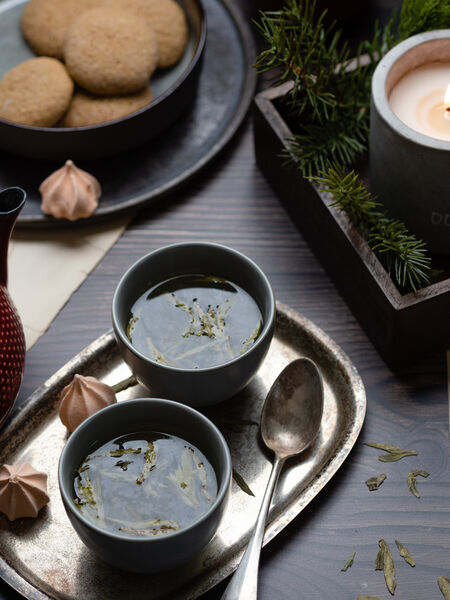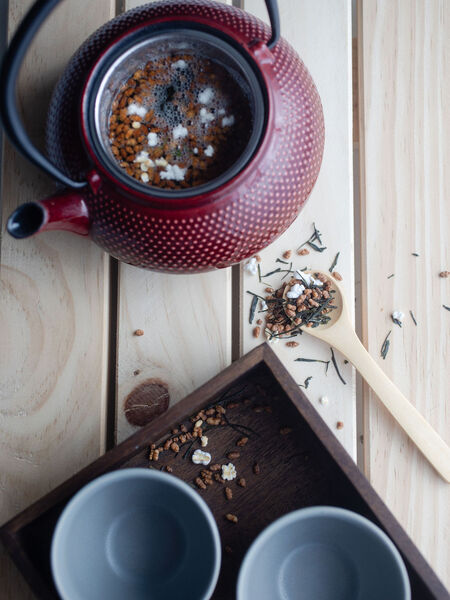Chinese vs Japanese Tea: Flavor & Style


We’ve all walked down the tea aisle at the store and have seen boxes labeled “Green Tea”, but does that mean all green teas are alike? Absolutely not! A tea is labeled “green” when its leaves are unoxidized (or exposed to oxygen), but green tea can come in a variety of flavors depending on how the tea is grown, processed, or even where it originated. Both China and Japan produce green tea, but the green teas they produce are processed, look, and taste differently. Discover the world of green tea from two different perspectives and find the next tea to grace your cup.
Production
While all true tea comes from the same Camellia sinensis plant, various factors, from basic care to the amount of shade, will determine how the tea will taste after it has been processed. In China, tea bushes are usually left alone in their natural environment until harvest time where they are picked by hand. In contrast, since tea is not a native plant of Japan, growing and harvesting tea is more involved, with terraces being constructed for the tea plants to thrive as well as some plants being shaded with tarps nearly a month before harvest. Much of the harvest in Japan is automated with machines, but that doesn’t mean that quality is sacrificed: even Japan’s finest teas are harvested this way.
In order to make a tea green and stop oxidation, tea manufacturers heat the leaves after harvest, which kills the enzyme that causes the leaves to oxidize. Most Chinese green teas are pan-fried in a wok whereas Japanese green teas are almost always steamed. There are a couple of exceptions to this rule, such as Chinese En Shi Yu Lu (which is steamed) and Japanese Kamairicha (which is pan-fried).
Appearance
Because of the vastness of the Chinese tea industry, Chinese green teas come in a variety of shapes and sizes. While some teas are simply pressed flat (such as the popular Dragonwell), many teas are twisted (like Pi Lo Chun) or hand rolled into pellets or pearls which unfurl as the tea is immersed in hot water (such as Gunpowder or Jasmine Pearls).
Very little is done to shape Japanese green teas during production. Most, such as Sencha and Gyokuro, come in long needle-like shapes with a deep shade of green. There are a few exceptions to this rule, such as Hojicha, a roasted green tea that is brown, and Matcha, a powdered green tea made from Gyokuro.
Price and Availability
Because China is the world largest producer and exporter of tea, it’s not surprising that Chinese green teas are easy to come by. Chinese green teas can be easily found in grocery stores, tea and coffee houses, and restaurants. By contrast, Japan’s industry is much smaller than China’s and only a fraction of what they produce is exported. Because of that, Japanese green teas are rarer and harder to find outside of specialty tea houses or tea stores.
Generally speaking, Chinese green teas are priced lower than Japanese green teas, but like in any other industry, there are some very high priced Chinese green teas as well as some lower-priced Japanese green teas depending on the tea.
Taste
Despite being made from the same bush, Chinese and Japanese teas have very different tastes. Because of the nature of being pan-fried, Chinese green teas are more forgiving when it comes to brew times and are easier to brew without becoming astringent or bitter. They brew with shades of gold and yellow and have light, toasty flavors, commonly described as nutty or sweet.
Japanese green teas are more delicate and should be brewed with more care since they can be over-brewed easily and become astringent. However, when brewed correctly, they have a very pleasant vegetal, grassy flavor with a mild or low astringency. Because they are shaded before harvesting, Japanese green teas (except for the roasted tea Hojicha) contain more chlorophyll (as well as other nutrients) and produce a green beverage.
Storage
Care should be taken when storing green tea, no matter where it comes from. While some rolled Chinese green teas can keep their flavor for three years, it’s recommended that green tea be used within a year of being opened. Store green tea away from sunlight in a cool area in an airtight container, preferably not made of glass.
What Should I Try First?
There are plenty of great green teas out there from both China and Japan. Those wanting to test the waters of Chinese green tea should try Sleeping Dragon, a nice introductory tea that is similar to Gunpowder tea without the smokey aroma. Dragonwell is another popular Chinese green tea that is mild and toasty. For those who love floral aromas should give Jasmine Scented teas a try.
Japan is known for great vegetal flavors in its tea. Sencha is a very popular choice in Japan for its pleasant refreshing and slightly astringent flavors. Gyokuro is one of Japan’s most prized green teas, with its sweet richness and contemplative brewing technique. Matcha has seen a surge in popularity in recent years and a good quality matcha is both delicious and filled with nutrients. If you want to try less vegetal Japanese teas, both the roasted Genmaicha (a green tea with popped rice) is a great alternative with a pleasantly toasty flavor.
Adagio also offers samplers of these teas on both Adagio and the Master's websites: Adagio's Green Teas of China, Adagio's Teas of Japan, and Master's Japan 2021 Sampler. There are a few Master's samplers for different Chinese regions.
